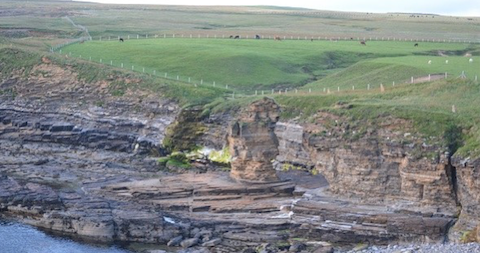
Orkney: Beside the Ocean of Time
This interdisciplinary project is a collaboration between Richard Irvine and his colleagues, with the Orcadian artist Anne Bevan, and The Pier Arts Centre, to find ways to investigate and represent time-depth in landscape, using Orkney as a model.
The action of the sea is constantly reshaping and reducing the islands of Orkney, eroding the glacial till and the underlying sandstone. A continuous gnawing, but with moments of drama that thrust deep time into the full glare of consciousness.
At what temporal resolution should we view human activity? In order to understand the processes of change that shape the landforms under our feet and the resources upon which we depend, we need to think beyond the short-term time-horizons of rapid economic transactions and electoral cycles – the days, months or even years of human time. Yet, if we attempt to place human activity against the backdrop of Deep Time – the vast and gradual time-scale of Earth’s geological history – the temporal span of a human life almost disappears. This presents Science and Humanities scholars with a conceptual challenge. In attempting to understand how communities respond and adapt to landscape change, we need to understand the factors that shape attitudes and behaviour, and the present-day, immediate context in which people narrate their lives. Yet understanding change also requires a deeper time perspective, one that recognises long-term histories of human settlement, in the context of deep time ecological and geomorphological transformations. With short-term time horizons, the understanding of the places where we live can only be in relation to a single point in environmental history; as such we risk locking ourselves into single point assumptions. If we expand our time horizons, recognising environmental fluctuation, we will increase communities’ resilience to landscape change. How, then, might thinking with a Deep Time perspective destabilise present-day certainties, and how might researchers work together to expand the time-depth of their work while remaining sensitive to the temporality of human experience?
This project brings together perspectives from Social Anthropology, Literature, Archaeology, Palaeoecology, and Geology, working in collaboration with Orcadian artist Anne Bevan and our project partner, The Pier Arts Centre, to find innovative ways to investigate and represent time-depth in landscape, using Orkney as a model. The project will develop and pilot an interdisciplinary methodology that will enable new insights into Orkney’s rich literary, geological, palaeoenvironmental and archaeological heritage, which is coupled with contemporary concerns over coastal erosion and the political and economic importance of energy generation.
Research Questions:
1) How do communities respond and adapt to landscape change?
2) What is the time-depth of people’s engagement with place?
3) How do we make deep time visible?
Researchers:
Niamh Downing, Literature, Falmouth University
Richard Irvine, Social Anthropology, University of Cambridge
Carina Fearnley, Science and Technology Studies, University College London
Tony Krus, Scottish Universities Environmental Research Centre
Lourdes Lopez-Merino, Institute for the Environment, Brunel University
Project partners:
Anne Bevan, Artist
The Pier Arts Centre
The project, part of the AHRC Science in Culture Programme, will culminate in a public Festival of Deep Time, in April 2017, which will include an exhibition, and a series of public workshops, talks and field-trips, that will enable us to undertake further ethnographic fieldwork, by involving the community in a dialogue about perceptions of time-depth and landscape change.
